The Sandman: Volume 7 – Brief LivesOriginal publication:
The Sandman #41–49 (September 1992 – May 1993)
Script: Neil Gaiman
Artwork: Jill Thompson (pencils)/Vince Locke (inks)/Dick Giordano (inks)
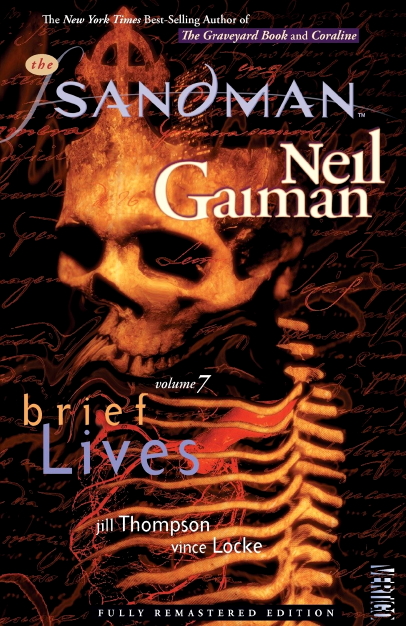 Publisher's synopsis
Publisher's synopsis:
Older and more powerful than the gods themselves, the Endless are a dysfunctional family of cosmic beings who have ruled over the realms of dream, desire, despair, destiny, destruction, death and delirium since the beginning of time. But 300 years ago, one of the mythical beings gave up his duties and left his realm, never to be seen again. Now on a mission to find their missing sibling, Delirium and older brother Dream encounter immortal humans and various deities as they try to locate the prodigal Destruction. But as their adventure draws Dream into a final, tragic confrontation with his son Orpheus, the eternal being learns the true meaning of fate and consequences.So, I recently finished reading volume 7 of
The Sandman and, a little later than promised, here's my review of it.

Unlike the last volume, which was mostly a collection of stand-alone stories, "Brief Lives" serves up a single ongoing adventure, with the basic premise being about Dream (a.k.a. Morpheus) and his sister Delirium embarking on a quest to locate their long-lost brother, Destruction. The whereabouts of Destruction had been a mystery to readers since he was first mentioned back in volume 4, "Season of Mists". So, this quest has been a little while in coming.
It's a fairly bizarre quest in its execution – especially Dream and Delirium's road trip – but it's one that touches every member of the Endless for the first time in the series. As such, "Brief Lives" deals with the subject of just who the Endless are and why they exist more than any other volume so far. As for Dream, he plays a prominent role throughout this collection, which, as you'll know if you are familiar with the series or have been following my reviews, isn't always the case.
After our story opens with a brief look at Dream's son Orpheus (who is now a severed, but fully concious head, following his run in with the Bacchante in "The Song of Orpheus"), the narrative quickly moves to the Dreaming, where we find Morpheus moping around his domain. Dream, it seems, was in love with a mortal woman (something that was mentioned in the last volume, although the identity of the woman is still a mystery), but she has left him, leaving him to sulk and generally act like an angsty teenager. To be fair, this isn't the first time we've seen this kind of immature, self-absorbed behaviour from Dream. Neil Gaiman gives the reader plenty of teasing hints as to the identity of this woman who has stolen and broken Dream's heart, but precious little concrete information about who she is. I assume that all will become clear in future instalments of the series.
Incidentally, while we're on the subject of Morpheus's past loves, Dream's assistant Lucien mentions another former lover of Dream's named Elanora, but I don't believe that she's been referenced in the series before. So, I'm thinking that this might be something that will tie into later events, perhaps?

Staying on the subject of Lucien for a moment, I love that we get another glimpse of Dream's library, which includes books that were never written, only dreamed of by their authors....

It was first revealed that Dream's library contained books that various authors had intended to write, but never got around to completing, back in "Season of Mists". Here among the imagined, but never realised tomes we have such impossibly rare titles as the missing Narnia book
The Emperor Over The Sea by C. S. Lewis and
The Last Voyage of Lemuel Gulliver by Jonathan Swift.
Note that the above panels show Mervyn Pumpkinhead, who is Dream's cigar-chomping janitor and who we first glimpsed in a fleeting appearance in "Preludes & Nocturnes". I like Merv a lot. His wise-cracking personality makes for some entertaining reading, and he's an obvious riff on Jack Pumpkinhead, who is one of my favourite characters from Frank L. Baum's
Oz books.
Anyway, returning to the main thrust of the book's plot, Dream's unstable and easily distracted sister Delirium is obsessing about her missing brother, Destruction, who we learn she was especially close to. After unsuccessfully petitioning both Desire and Despair to help search for her brother, Delirium goes to Dream, who somewhat reluctantly agrees to accompany her on her journey. His reasons for doing so seem to be little more than the fact that it will provide a much needed distraction from his current romantic woes.
It's clear from Delirium's interactions with Desire and Despair that the Endless family isn't a particularly close one – especially since in the 300 years since he left, this is the first time that anyone has thought to look for Destruction. Still, there's probably an issue of scale to consider here: 300 years might seem like a long time to us, but it's the blink of an eye as far as the Endless are concerned. I mean, Dream went missing himself for decades in volume 1, "Preludes & Nocturnes", and yet not one of his siblings ever came searching for him. On a related note, I think that "Brief Lives" is the first story in the series where it really feels like the Endless are a proper family – albeit a fairly dysfunctional one – rather than just a group of inter-connected immortals or demigods.
We first met Delirium back in volume 4, "Season of Mists" and encountered her again in volume 6, "Fables & Reflections". One of the most interesting things we learn here is that was once Delight. I have to say that, as a character, she's every bit as memorable as Dream or Death, but I do find her rambling, scatter-brained personality to be more than a little irritating. I don't think she's as intriguingly whimsical or as funny a character as Gaiman thinks she is. Even Dream himself seems as bored with her as I was; when her bother needs to speak to her, he mostly does so in a non-committal, disinterested tone...
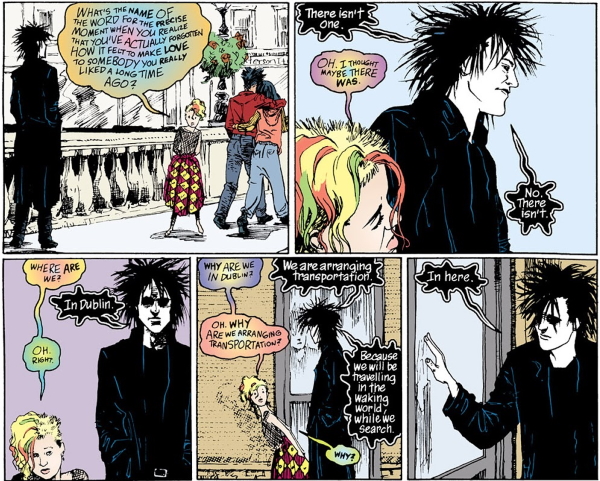
Together, Dream and Delirium attempt to track down a number of incredibly long-lived humans and demigods, including Bast, Queen and Goddess of Cats, and Dream's son Orpheus, who may be able to shed some light on Destruction's whereabouts. One of the best things about this quest is that it enables Gaiman and artist Jill Thompson to give us the surreal, but quite wonderful sight of Dream, his sister, and Matthew the raven cruising around in a vintage car...
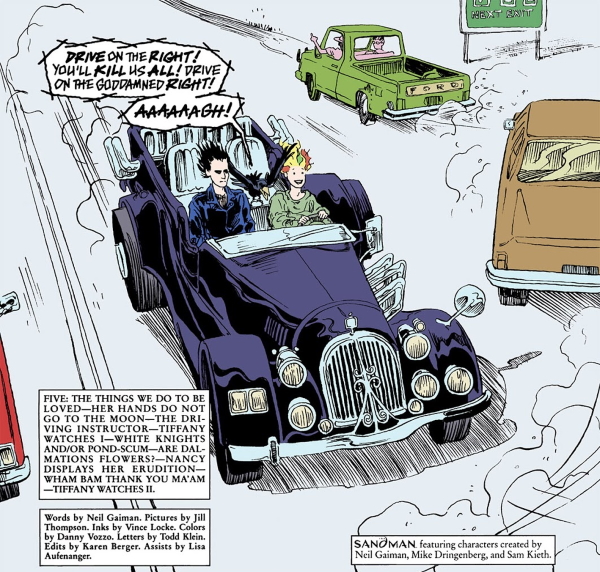
Initially, the Endless siblings are assigned a chauffeur named Ruby, but she unfortunately dies in a motel room fire, after accidentally falling asleep smoking a cigarette, which is a shame because she seemed like a fairly interesting character. Actually, accidental death befalls a lot of the people Dream and Delirium approach for information, which, it turns out, is due to certain safeguards that Destruction has put in place to thwart those who may attempt to seek him out.
At one point in their quest, the two Endless siblings visit a strip club in Dublin, Ireland, called Suffragette City, where the goddess Ishtar is now working ("Suffragette City" is perhaps
the most ironic name for a strip club ever). I really enjoyed the scenes in the strip club a lot – and not for any lusty, base reasons! It was because the dialogue and characterisation was smart, funny, and thought-provoking. The plight of the Goddess, who is now reduced to whatever little adoration she can get from the patrons of a seedy strip-club, despite having been worshipped by millions in antiquity, was rather tragic. In addition, Ishtar's lethally seductive dance – which is more than the eyes and minds of human males can bear – provides this volume with one of its most memorable scenes. Still, you can't help feeling sorry for the hapless guys who just wanted to relax and watch a strip show, but instead ended up getting their minds blown out by an ancient Babylonian goddess.

I would post a scan of this sequence, but it's decidedly NSFW.
Ultimately, the siblings' investigations lead nowhere and Dream abruptly ends their quest, which greatly upsets Delirium. It is Death who eventually intervenes and urges Morpheus to reconcile with his sister, so that they may continue their search for Destruction.
Something that doesn't sit particularly well with me in this quest is that Delirium causes an awful lot of real damage on Earth, which she seems blissfully unaware of. Even Dream seems disinterested in how his sister's presence effects the mortals she encounters. For example, at one point Delirium curses a highway patrolman, who, quite sensibly, has pulled her over due to her hugely dangerous driving, with visions of insects crawling all over his body forever...
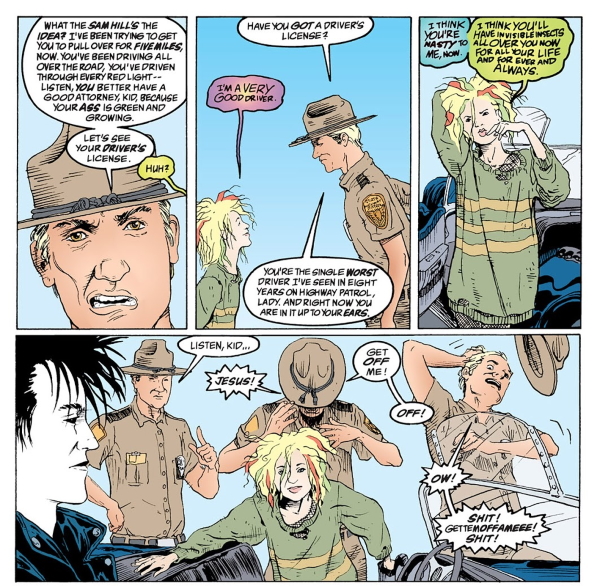
Later on in the book we see that the unfortunate cop will indeed have to spend the rest of his life in a tortured and psychotic state, which seems more than a little unfair. He was, after all, only doing his job! That two of the Endless should capriciously inflict such cruel torture on a mortal, when there were any number of kinder alternatives, leaves a bad taste in my mouth.
Dream and Delirium finally track down their missing brother, with help from the oracle Orpheus. It's kind of surprising that Destruction has the appearance of a bohemian beach bum or surfer dude, complete with annoying early '90s ponytail. As we saw from his brief appearance in "Fables & Reflections", Destruction is a jovial and spirited individual, who certainly seems to be enjoying his alone time since abdicating his role within the Endless family. He seems to spend most of his time on a remote island, sculpting, painting, writing poetry, and cooking, with just his talking dog Barnabas for company...
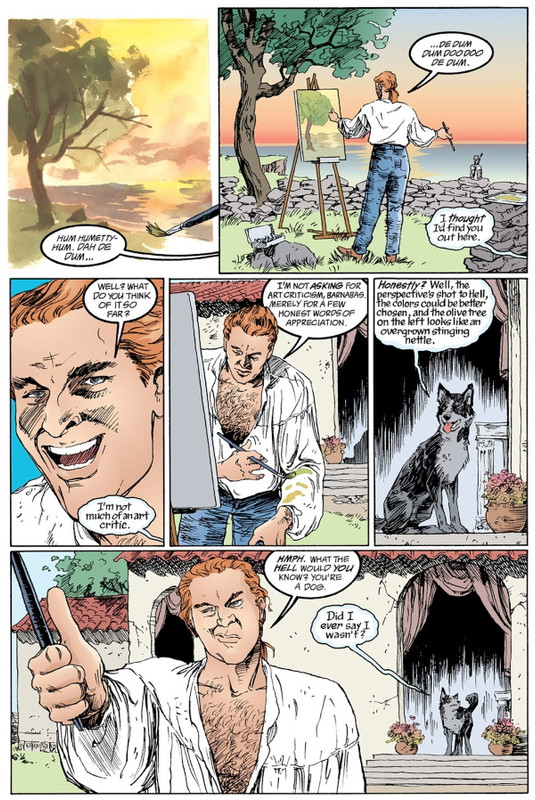
The reasons why Destruction ceded his duties and hid himself away are kind of nebulous, but it appears that, as humanity became more enlightened in the 17th century, he felt dissatisfied with the direction that mortals were taking and wanted to find new meaning in his life. He also makes some interesting comments on the nature of the Endless and the role that they fulfil in the universe, describing them as, "merely patterns" and "repeating motifs." As such, he knew that acts of destruction would continue, even without the living embodiment of destruction at the helm. You see, the "motifs" or "patterns" were already there and the universe would take care of the rest.
So basically, Destruction has had the Endless' equivalent of a mid-life crisis!

As a result, the former Lord of Destruction wanted to try his hand at creating some things, instead of destroying them, which isn't all that surprising when you consider how closely intertwined creation and destruction are. On a related note, I got to wondering whether it was significant that the Endless sisters who are closest to Destruction are Despair and Delirium? And whether Gaiman was trying to make a point here? Based on what I know about his writing, he almost certainly was, I think.
Gaiman provides the reader with a lot of seemingly thought-provoking concepts via Destruction's dialogue, as he explains the reasons for his abdication. He cites the stars in the firmament above as providing the illusion of permanence, when in reality mortals die, gods come and go, and even the stars are ephemeral, within the context of their own huge lifespans. This, of course, all ties in to the book's title, with Death at one point reminding us that we all get what anybody gets...a lifetime. No more. No less.
However, I have to say that Death's attendant suggestion that we all already know everything that Destiny knows, but we just tell ourselves that we don't to make life bearable is absolute poppycock! This just smacks of Gaiman trying to sound clever and mysterious. Even Destruction finds Death's statement somewhat unlikely, and he tells Dream, "I never knew what to make of that." Well, quite.
This is a recurring problem for me in "Brief Lives". Gaiman's dialogue is as strong as ever, and it's certainly crammed with fascinating philosophical nuggets for the reader to ponder. However, while some of these are quite profound, some of them don't stand up to even a moment's cursory examination. This cod-philosophy overload, coupled with Morpheus's sulky demeanour and Destruction's fifth-form, New Age theorising gives the narrative quite an adolescent "voice" at times. It really is kind of hard to know exactly what Gaiman is trying to say with this book.
I mean, I
feel as if he's saying something profound, but it doesn't quite come off. I also think that there's some kind of subtext struggling to break through the surface of the narrative, what with the central cast seeking "destruction." Trouble is, this subtext is too ill-defined to really work (at least for me). I don't really get Gaiman's point, and I'm not even convinced that there is one. At least, not a good one.
Still, Destruction's somewhat unconvincing philosophising does provide artist Jill Thompson with the opportunity to give us this gorgeous double-page spread...
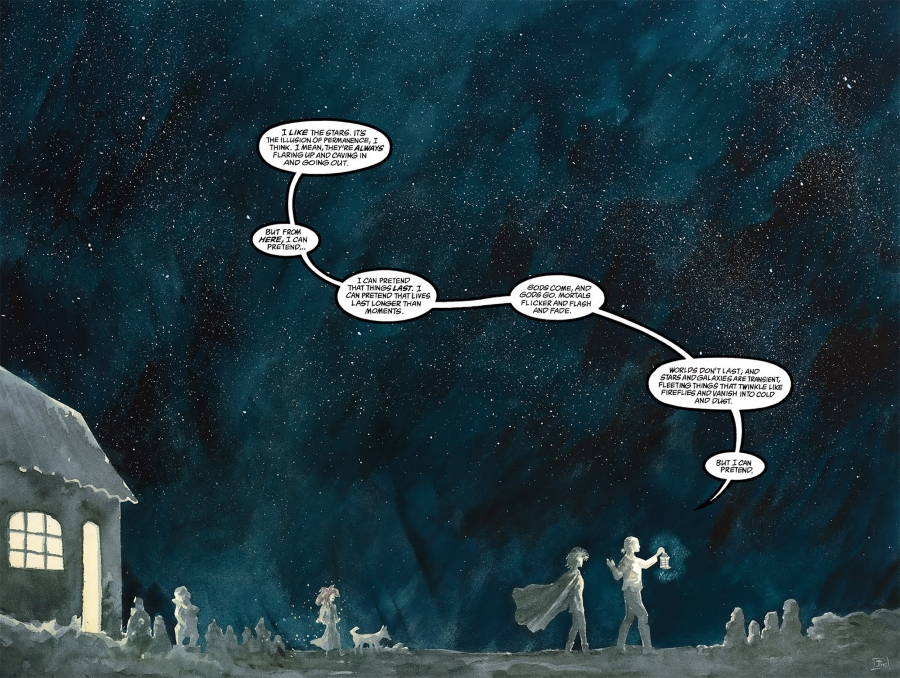
Thompson's artwork is really nice throughout and Vince Locke's inks and her pencils work really well together. It's unusual in this series to have an entire volume drawn by mostly the same artistic team (the veteran comic artist Dick Giordano subs on inks for part of issue #47, which, incidentally, was the first issue of
The Sandman to be published under the Vertigo imprint). Having Thompson and Locke work on every issue gives "Brief Lives" a pleasing artistic uniformity that most other volumes in the series have lacked.
Our story ends with Destruction leaving the mortal plane, but not before giving Barnabas to his sister Delirium and ordering him to look after her. It then falls to Dream to visit his son Orpheus and kill him – something that he had earlier promised to do, but which violates the Endless' own rules. Ultimately, Dream agreeing to end his son's life is an act of mercy. In this, as with other moments earlier in the series, we can see that Morpheus has matured as a character, in large part, it seems, due to his interactions with mortals. With Delirium satisfied that her long-lost brother is safe and well, she returns to her realm.
As Dream leaves Orpheus's temple and returns to the Dreaming, Despair materialises and plucks a flower that is growing in the temple grounds to present to Desire. As was hinted in book 2, "The Doll's House", Desire definitely seems to be laying some kind of trap for Morpheus; the genderless being asks Despair about the toll that encountering Destruction has had on her brother and is cryptically told by her sister that, "you cannot seek Destruction and return unscathed." Exactly what Desire has planned is still anyone's guess, but I imagine all will become clear before too long.
Overall, "Brief Lives" was a pretty enjoyable read, but it didn't blow me away like earlier books in the series have. The story is a good one, but it feels quite long (it has 9 parts) and at times it was kind of a chore to get through. I mean, it was still enjoyable, but it wasn't a page-turner like most of the previous volumes have been. Then there's Gaiman's slightly clumsy philosophising and ill-defined grasping for a subtext, which feels both half-realised and a bit immature, to be honest. Still, there's plenty to like about this volume of
The Sandman; the ending, in particular, is both poignant and wholly satisfying. But yeah, I certainly don't feel that "Brief Lives" is up there with the best books in the series.




















